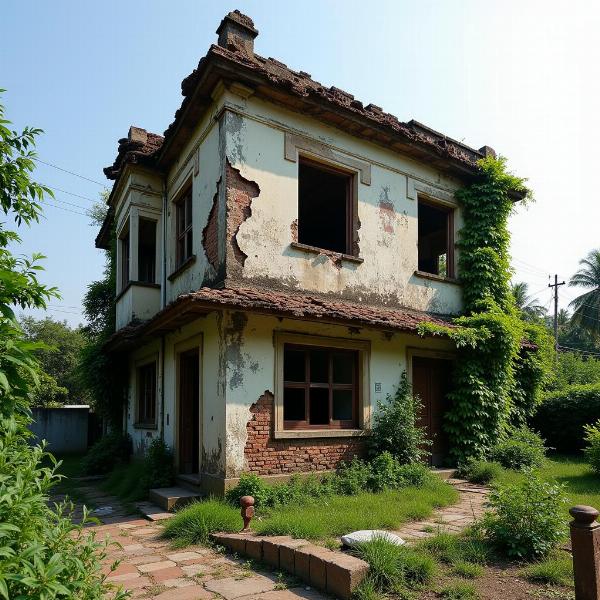Decrepit meaning in Hindi encompasses a range of words that describe the state of being worn out, dilapidated, or weakened by age or neglect. Understanding the subtle differences between these synonyms allows for more accurate and nuanced communication, especially when translating between Hindi and other languages. This article explores the various Hindi words used to convey the meaning of “decrepit,” examining their cultural context and practical applications.
Exploring Hindi Synonyms for “Decrepit”
Several Hindi words capture the essence of “decrepit,” each with its unique connotations:
-
जर्जर (jarjar): This is perhaps the closest equivalent to “decrepit” in Hindi. It describes something that is worn out, tattered, or in a state of disrepair due to age or neglect. Think of a jarjar building with crumbling walls and broken windows.
-
जीर्ण-शीर्ण (jirn-sheern): This compound word emphasizes the state of being decayed and dilapidated. It often describes ancient ruins or structures that have been ravaged by time. Imagine a jirn-sheern temple, overgrown with vegetation and bearing the marks of centuries past.
-
पुराना (purana): While simply meaning “old,” purana can sometimes imply decrepitude, especially when referring to objects or systems that are outdated and no longer functional. A purana car, for instance, might be rusty, unreliable, and in need of significant repairs.
-
कमजोर (kamzor): This word translates to “weak” and often describes a person or animal whose physical strength has declined due to age or illness. While not directly synonymous with “decrepit,” it can be used in a similar context to describe a frail, elderly individual.
 Old, dilapidated building in India
Old, dilapidated building in India
Decrepitude in Indian Culture and Literature
The concept of decay and decline holds a particular significance in Indian culture, often symbolized by the cycle of creation and destruction. Ancient texts and scriptures frequently allude to the transient nature of material things, emphasizing the importance of spiritual growth and detachment. The imagery of jirn-sheern temples and crumbling monuments serves as a potent reminder of the impermanence of worldly possessions.
Practical Applications of “Decrepit” in Hindi Translation
Accurately translating “decrepit” requires careful consideration of the context. For instance, when translating legal documents related to property, using jarjar might be most appropriate to describe a dilapidated building. In literary works, jirn-sheern might be a more evocative choice to describe ancient ruins. When referring to a person’s health, kamzor might be the most suitable term.
What are the different connotations of “decrepit” in Hindi?
Different Hindi words offer varying shades of meaning to “decrepit,” from the general wear and tear of jarjar to the ancient decay of jirn-sheern. Understanding these nuances is crucial for accurate translation.
How does Indian culture view the concept of decrepitude?
Indian culture often views decrepitude through a philosophical lens, connecting it to the cycle of creation and destruction and emphasizing the impermanence of material things.
Why is it important to choose the right Hindi word for “decrepit”?
Selecting the appropriate synonym for “decrepit” ensures accurate and nuanced communication, avoiding potential misunderstandings and misinterpretations.
Conclusion: Navigating the Nuances of Decay
Understanding the various Hindi words for “decrepit” provides a deeper understanding of the language and its cultural context. Choosing the right word allows for more precise communication, ensuring that the intended meaning is conveyed accurately and effectively. By exploring the subtle nuances of these words, we can appreciate the richness and depth of the Hindi language.
- What is the closest Hindi equivalent to “decrepit”? Jarjar is generally considered the closest equivalent.
- How is “decrepit” used in legal contexts in Hindi? Jarjar is often used to describe dilapidated properties in legal documents.
- What word describes ancient ruins in Hindi? Jirn-sheern is commonly used to describe ancient ruins.
- What Hindi word describes weakness due to age? Kamzor is used to describe weakness due to age or illness.
- How does Indian literature use the concept of decrepitude? Indian literature often uses decrepitude to symbolize the transient nature of life and the importance of spiritual growth.
- Why is understanding the nuances of “decrepit” important in Hindi? Understanding the nuances ensures accurate communication and avoids misinterpretations.
- What is the significance of purana in the context of “decrepit”? While meaning “old,” purana can imply decrepitude when referring to outdated or non-functional items.
Meaning-Hindi.in is your trusted partner for professional Hindi translation services. We specialize in a range of translation needs, from business and legal documents to technical manuals and website localization. Our team of expert Hindi linguists ensures accurate and culturally sensitive translations. Contact us today for your translation needs at [email protected] or +91 11-4502-7584. Let Meaning-Hindi.in bridge the language gap for you.